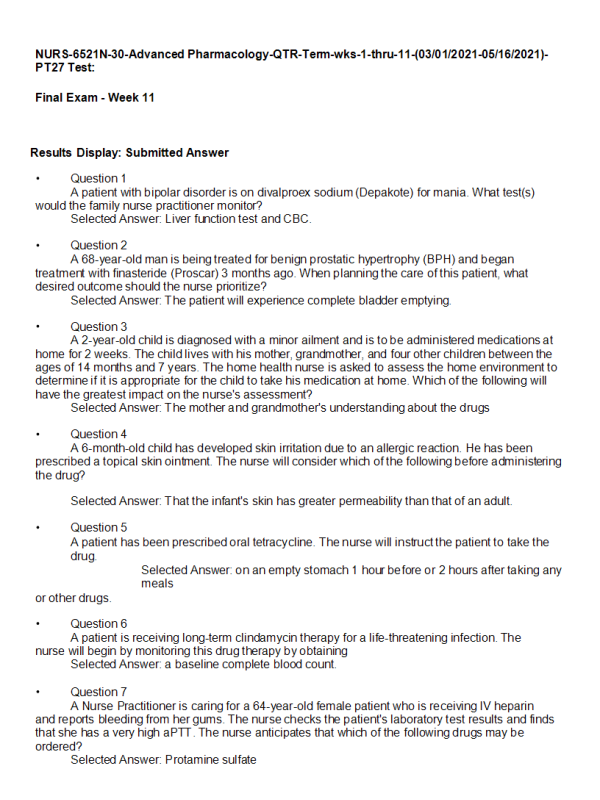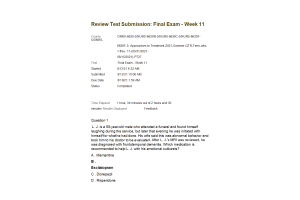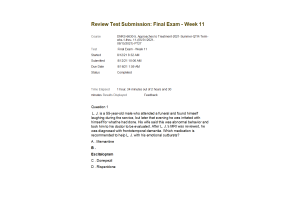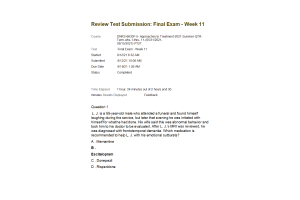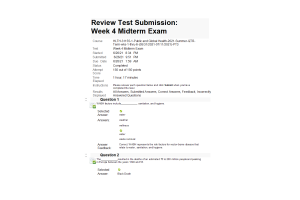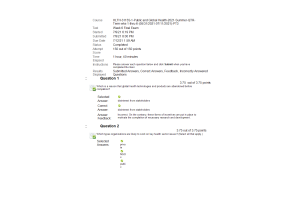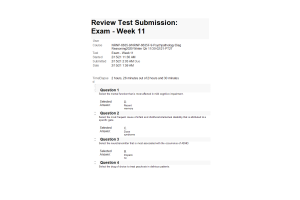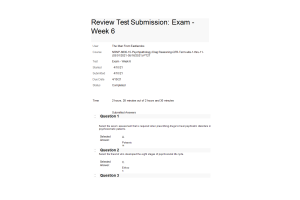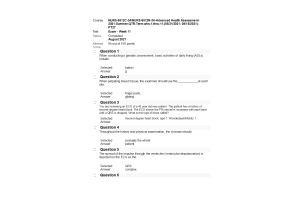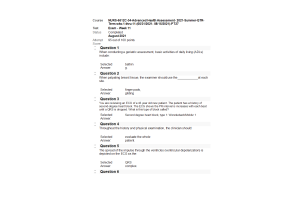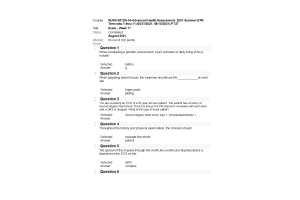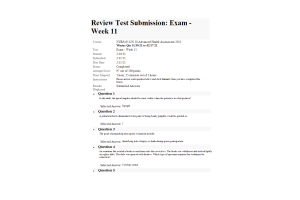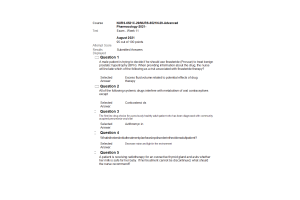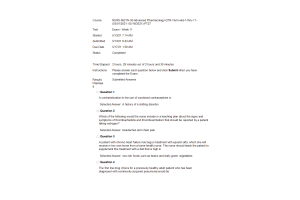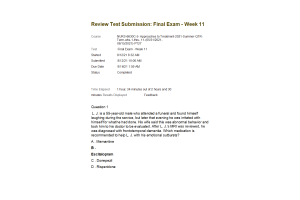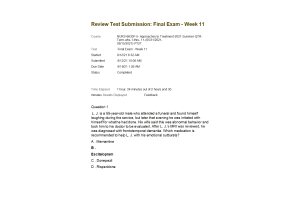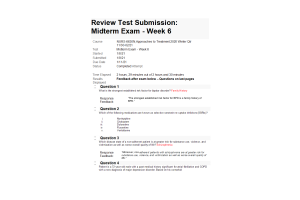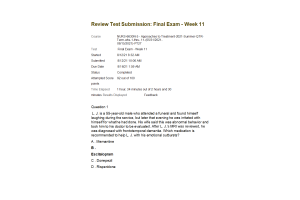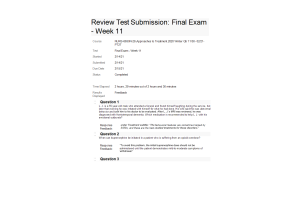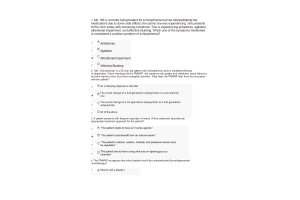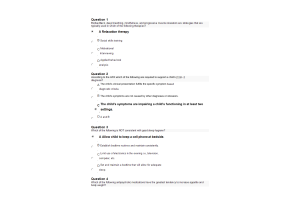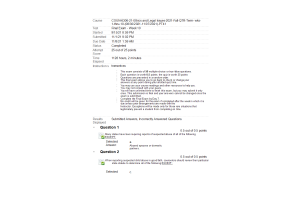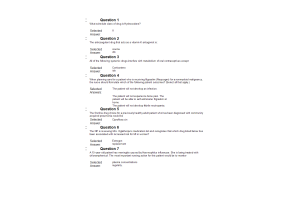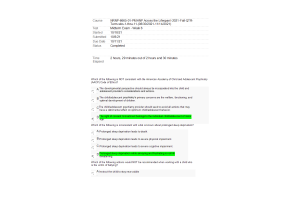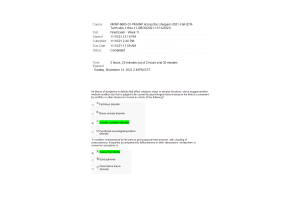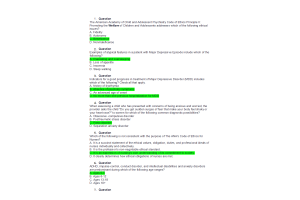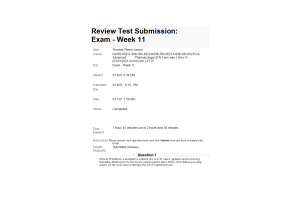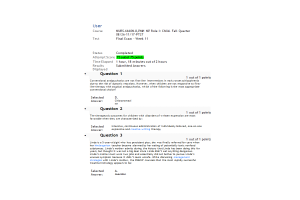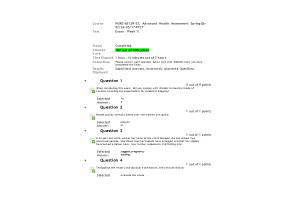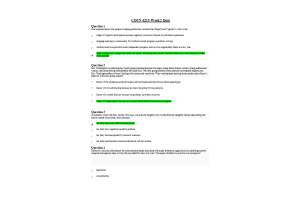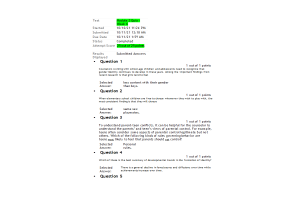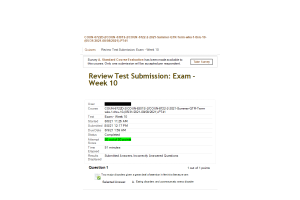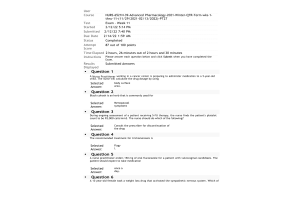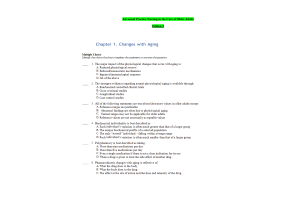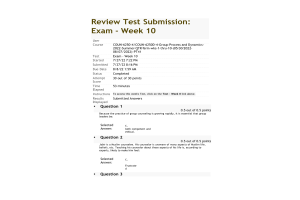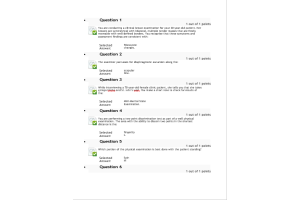NURS 6521N-30, Week 11 Final Exam
- $49.00
- Question: A patient with bipolar disorder is on divalproex sodium (Depakote) for mania. What test(s) would the family nurse practitioner monitor?
- Question: A 68-year-old man is being treated for benign prostatic hypertrophy (BPH) and began treatment with finasteride (Proscar) 3 months ago. When planning the care of this patient, what desired outcome should the nurse prioritize?
- Question: A 2-year-old child is diagnosed with a minor ailment and is to be administered medications at home for 2 weeks. The child lives with his mother, grandmother, and four other children between the ages of 14 months and 7 years. The home health nurse is asked to assess the home environment to determine if it is appropriate for the child to take his medication at home. Which of the following will have the greatest impact on the nurse's assessment?
- Question: A 6-month-old child has developed skin irritation due to an allergic reaction. He has been prescribed a topical skin ointment. The nurse will consider which of the following before administering the drug?
- Question: A patient has been prescribed oral tetracycline. The nurse will instruct the patient to take the drug.
- Question: A patient is receiving long-term clindamycin therapy for a life-threatening infection. The nurse will begin by monitoring this drug therapy by obtaining
- Question: A Nurse Practitioner is caring for a 64-year-old female patient who is receiving IV heparin and reports bleeding from her gums. The nurse checks the patient's laboratory test results and finds that she has a very high a PTT. The nurse anticipates that which of the following drugs may be ordered?
- Question: A nurse practitioner orders 150 mg of oral fluconazole for a patient with vulvovaginal candidiasis. The patient should expect to take medication
- Question: Which adverse reaction is common in the patient taking buspirone?
- Question: A 62-year-old patient taking tamoxifen exhibits increased bone and tumor pain along with a local disease flare. The nurse interprets this as an indication of which of the following?
- Question: The first line drug choice for a previously healthy adult patient who has been diagnosed with community acquired pneumonia would be
- Question: Which of the following medications will not increase the likelihood of photosensitivity?
- Question: A woman who is in the second trimester of her first pregnancy has been experiencing frequent headaches and has sought advice from her nurse practitioner about safe treatment options. What analgesic can the nurse most safely recommend?
- Question: A patient is taking etoposide for a testicular tumor refractory to treatment. The nursing assessment reveals that he is also taking warfarin. The nurse must carefully monitor for which of the following?
- Question: A patient is to begin taking tobramycin (Nebcin) for a nosocomial infection. Which of the following assessments should the nurse prioritize?
- Question: The clinical nurse educator who oversees the emergency department in a children's hospital has launched an awareness program aimed at reducing drug errors. What measure addresses the most common cause of incorrect doses in the care of infants and children?
- Question: Which antibiotic is most frequently associated with "Red man Syndrome”?
- Question: A pregnant patient who has diabetes has been admitted to the hospital to begin labor. Since the patient has diabetes, the physician has decided to use oxytocin (Pitocin) to initiate labor contractions. When talking to the patient about the adverse effects of the drug, the nurse should understand that the most common adverse effects of the drug include
- Question: A male patient is taking finasteride for BPH. Which of the following will the nurse evaluate at each clinic
visit?
- Question: A 43-year-old man has been diagnosed with active TB. He is prescribed a multiple drug therapy, including INH and rifampin. A priority assessment by the nurse will be to monitor which combination of laboratory test results?
- Question: An immunocompromised patient in a critical care setting has developed a respiratory infection that has been attributed to methicillin-resistant Staphylococcus aureus (MRSA). The nurse should anticipate that the patient will require treatment with
- Question: Which of the following would a Nurse Practitioner assess for in a patient who is taking polymyxin B systemically?
- Question: A 60-year-old patient experienced a sudden onset of chest pain and shortness of breath and was subsequently diagnosed with a pulmonary embolism in the emergency department. The patient has been started on an intravenous heparin infusion. How does this drug achieve therapeutic effect?
- Question: Which test should the NP order for monitoring effectiveness of the patient receiving heparin?
- Question: Which of the following drugs is most likely to cause sexual dysfunction and males?
- Question: patient will soon begin targeted therapy as a component of her treatment plan for chronic leukemia. The nurse is conducting health education about this new aspect of the patient's drug regimen and the patient has asked about the potential side effects of treatment. How should the nurse best respond?
- Question: A 45-year-old female patient is prescribed ciprofloxacin to treat a bronchial infection. A nursing assessment revealed that she started taking daily vitamin supplements about 2 years ago. To maximize the therapeutic effects of the ciprofloxacin therapy, the nurse should advise the patient to
- Question: Finasteride (Proscar) is prescribed for a 50-year-old man who is experiencing a problem with urination secondary to an enlarged prostate. The practitioner would teach the patient that while he is taking this medication, it is important to:
- Question: An oncology nurse is aware of the risks for injury that exist around the preparation, transportation, and administration of chemotherapeutic agents. In order to reduce these risks of injury, the nurse should take which of the following actions?
- Question: The laboratory monitoring required when a patient is on a selective serotonin reuptake inhibitor is?
- Question: A 9-year-old boy was bought to his primary care provider by his mother with signs and symptoms of hookworm infection and will be sent home with a prescription for mebendazole. When provided patient and family education, the nurse should teach the mother with which of the following measures to avoid reinfection following treatment?
- Question: Which Of the following pharmacologic agents can be used to treat nicotine dependence/ smoking cessation?
- Question: A Nurse Practitioner is providing patient education to a 50-year-old woman who is taking methotrexate (MTX) for breast cancer. The nurse will instruct the patient to avoid which of the following drugs?
- Question: A 13-year-old patient has juvenile arthritis. He has recently had oral surgery and was told by the surgeon to take aspirin for the pain. The APRN will monitor for which of the following?
- Question: A patient is taking flavoxate hydrochloride (Urispas) to help control an overactive bladder. On a follow- up visit to the clinic, the nurse will question the patient about which of the following?
- Question: A postmenopausal patient is prescribed bisphosphonates to treat osteoporosis. The nurse will instruct the patient to take the drug
- Question: What is the minimum inhibitory concentration (MIC)
- Question: A quinolone used to treat a urinary tract infection would be contraindicated in:
- Question: Donald is a nurse practitioner student. He recognizes Which option below could be a secondary use for an anxiolytic medication?
- Question: The Nurse Practitioner has established peripheral IV access and begun an infusion of magnesium sulfate on a 29-year-old antepartum patient who is 35 weeks pregnant. Which of the following assessment findings most likely prompted the patient's physician to order magnesium sulfate for this patient?
- Question: Mr. Asberry is taking Levofloxacin for his sinusitis. He calls your clinic and reports some pain just above the heel of his left foot. The NP should:
- Question: Baby Jasmine is a 5 mth old breastfed infant with a fever. Treatment for her fever may include:
- Question: Mr. CW has his routine appointment today in your clinic. He has been taking 10 mg of prednisone per day for the past six months. He should be assessed for
- Question: A 56-year-old woman will soon begin treatment of her overactive bladder with tolterodine (Detrol).
- Question: All of the following systemic drugs interfere with metabolism of oral contraceptives except Selected
- Question: A school nurse has been teaching high school students about the risks associated with marijuana use. However, the nurse has been met with considerable skepticism on the part of students, most of whom believe that marijuana is a benign drug. Which of the following teaching points should the nurse provide?
- Question: A 19-year-old patient reports to a clinic with vaginal discharge with a foul odor. A microscopic exam reveals trichomonas vaginalis. The nurse practitioner is aware that
- Question: The nurse practitioner orders Amoxicillin 500 mg tid? What is the total amount of medication patient will take per day?
- Question: A Nurse Practitioner is caring for a patient who is at 28 weeks' gestation and is receiving terbutaline (Brethine) to control preterm labor. Which of the following assessment parameters should the nurse prioritize?
- Question: Phenytoin decreases folic acid absorption by
- Question: Labors confirmed that a patient has chloroquine-resistant malaria and the patient's physician has prescribed quinine along with an adjunctive drug. The nurse should question the physician's order if the patient has a history of
- Question: A Nurse Practitioner is working with a 16-year-old pregnant teen and assessing for behavior that may put the baby at risk. The most important assessment the nurse can make is
- Question: The Nurse Practitioner knows that Buproprion use (wellbutrin, zyban) is contraindicated in which of the following install
- Question: John, the Nurse Practitioner is prescribing Fosamax for his patient. Bisphosphonate administration education includes
- Question: Lily, the nurse practitioner is seeing Mr. Reynolds today. She would recognize that which of the following is a potential adverse side effects of autonomic-anticholinergic agents?
- Question: A Nurse Practitioner is caring for a patient who is on amphotericin B. On morning rounds the patient reports weakness, numbness, and a tingling sensation in his feet. What would be a priority action by the nurse?
- Question: A child with chronic allergic symptoms uses an intranasal steroid for control of symptoms. At this child's annual well-child checkup, the NP should carefully review what?
- Question: A 12-year-old boy is being discharged from the hospital after major surgery. The boy will be taking two medications at home for an extended period. The nurse who is discharging the patient should provide medication teaching specifically to
- Question: A patient is prescribed ganciclovir to treat a CMV infection. An oral dosage is prescribed. To help increase bioavailability of the drug, the nurse will encourage the patient to take the medication
- Question: A nurse practitioner orders a single dose of 2 g Metronidazole orally. How many milligrams will the patient receive in one dose?
- Question: A 16-year-old boy is prescribed cromolyn sodium nasal spray to treat a nasal allergy. To maximize the therapeutic effects of the drug, which of the following will the nurse include in instructions to the patient?
- Question: A 29-year-old pregnant patient is extremely upset about having to take medication for a pre-existing medical condition. She is consumed with fear that her baby will be born with a physical deformity or a congenital anomaly but knows that she has to take the medication. She talks constantly about this and is unable to sleep most nights. Which of the following is the most appropriate nursing diagnosis for this patient is?
- Question: A woman has a Chlamydia infection. Before initiating treatment with a tetracycline antibiotic, the NP should:
- Question: How do bisphosphonates Treat osteoporosis?
- Question: A Nurse Practitioner is assessing a patient who has chronic lymphoblastic myelogenous leukemia. The treatment plan includes hydroxyurea (Hydrea). The nurse will assess the patient for which of the following?
- Question: Which of the following is a true statement about aspirin and its action on platelets
- Question: Which of the following agents would not be expected to cause nausea, vomiting, Flushing, dizziness, headache, and abdominal discomfort after consumption of alcohol?
- Question: An NP is seeing a child who weights 25 pounds, 2 oz and needs a medication. The NP learns that the recommended dosing for this drug is 30-35 mg per kg per day in three divided doses. The NP should order
- Question: A 45-year-old woman with acute leukemia is going to begin chemotherapy with vincristine. The nurse is aware that vincristine must always be administered
- Question: Which of the following drugs can a person with G6PD deficiency take safely?
- Question: A 54-year-old woman with a history of osteoporosis has been prescribed ciprofloxacin for recurrent cystitis. Because of the patient's history, the nurse would be sure to discuss with the woman the use of
- Question: The nurse practitioner has prescribed elemental iron 6 mg/kg/day in three divided doses for a toddler diagnosed with iron-deficiency anemia. What instructions would the family nurse practitioner include for the parents?
- Question: Steady state is:
- Question: What is the first line treatment for hypertension and a male with benign prosthetic hypertrophy?
- Question: A patient is being seen in the emergency department for a sprained ankle and is given a drug to relieve pain. When a second dose of the pain medication is given, the patient develops redness of the skin, itching, and swelling at the site of injection of the drug. The most likely cause of this response is
- Question: Sulconazole has been prescribed for a patient with tinea pedis. The nurse will instruct the patient to use the topical agent
- Question: A 71-year-old man has just been prescribed finasteride (Proscar). Which of the following complaints by this patient most likely indicated a need for this drug?
- Question: A patient reports to a clinic with complaints of breast tenderness, a right lumpy breast, and no breast discharge. The breast tenderness occurs primarily during her menstrual cycle. The nurse practitioner probably suspects
- Question: A woman is receiving prolonged drug therapy during her complicated pregnancy, and it may pose a risk to both the mother and the fetus. The primary care physician has made dosage adjustments to minimize adverse effects and prevent toxicity. The nurse should make sure
- Question: A nurse practitioner has been assigned to a 55-year-old woman who has a malignant brain tumor. The patient is receiving her first dose of carmustine. It will be critical for the nurse to observe for which of the following?
- Question: The NP has just placed Mr. Johnson on a selective serotonin reuptake inhibitor. What symptoms should be reviewed with the patient who is newly prescribed this class of medication
- Question: An immunocompromised cancer patient has developed cryptococcal meningitis and been admitted to the intensive care unit for treatment with amphotericin B. How should the nurse most safely administer this drug?
- Question: All insects have an FDA black box warning regarding
- Question: A male patient has been brought to the emergency department during an episode of status epilepticus.Diazepam is to be administered intravenously. The APRN will be sure to
- Question: A woman is receiving magnesium sulfate for intrapartum eclampsia. The patient is perspiring and her blood pressure is 88/50. The serum magnesium level is 10 mg/dL. The nurse will interpret these manifestations as
- Question: A 34-year-old male has been diagnosed with TB and will be started on INH therapy. The medication history reveals that he currently takes antacids on a regular basis. The nurse will instruct the patient to take
- Question: A 7-year-old child has been taking tetracycline for a bacterial infection. The nurse will be sure to inform the parents that this drug could cause
- Question: A 13-year-old female took a weight loss drug that activated the sympathetic nervous system. Which of the following assessment findings would the nurse expect?
- Question: The NP is reviewing Mrs. Oglethorpe's medication list and recognizes that which drug listed below has been associated with increased risk for MI in women?
- Question: A Nurse Practitioner is instructing a 19-year-old female patient on the use of fluconazole for candida vaginitis. A teaching priority will be to
- Question: A Nurse Practitioner educator who coordinates the staff education on an oncology unit is conducting an in-service on targeted therapies. What potential benefit of targeted therapies should the nurse highlight in this education session?
- Question: Women who are prescribed progestin-only contraception need education regarding which common adverse drug effect?
- Question: A Nurse Practitioner has completed a medication reconciliation of a patient who has been admitted following a motor vehicle accident. Among the many drugs that the patient has received in the previous year is rituximab. The nurse would be justified in suspecting the patient may have received treatment for which of the following diseases?
- Question: A 21-year-old has been placed on risperidone. Monitoring for risperidone includes Selected Answer:
- Question: A patient is receiving radiotherapy for an overactive thyroid gland and asks whether her milk is safe for her baby. If her treatment cannot be discontinued, what should the nurse recommend?
- Question: During ongoing assessment of a patient receiving 5-FU therapy, the nurse finds the patient's platelet count to be 92,000 cells/mm3. The nurse should do which of the following?
- Question: Monitoring of male patients are using phosphodiesterase type 5 (PDE-5) inhibitors includes which of the following?
- Question: A 72-year-old patient is prescribed ophthalmic ciprofloxacin for a bacterial infection in her right eye.
The nurse will teach her to observe for which of the following adverse effects of the drug?
- Question: Ms. LW is on hyrdroxychloroquine (Plaquenil) for rheumatoid arthritis. Certain tests are recommended before a patient starts this medication. Which of the following is NOT recommended before starting Hydroxychoroquine (Plaquenil)?
- Question: A patient is taking rifampin (Rifadin) for active TB. When discussing this drug with the patient, the nurse should stress that
